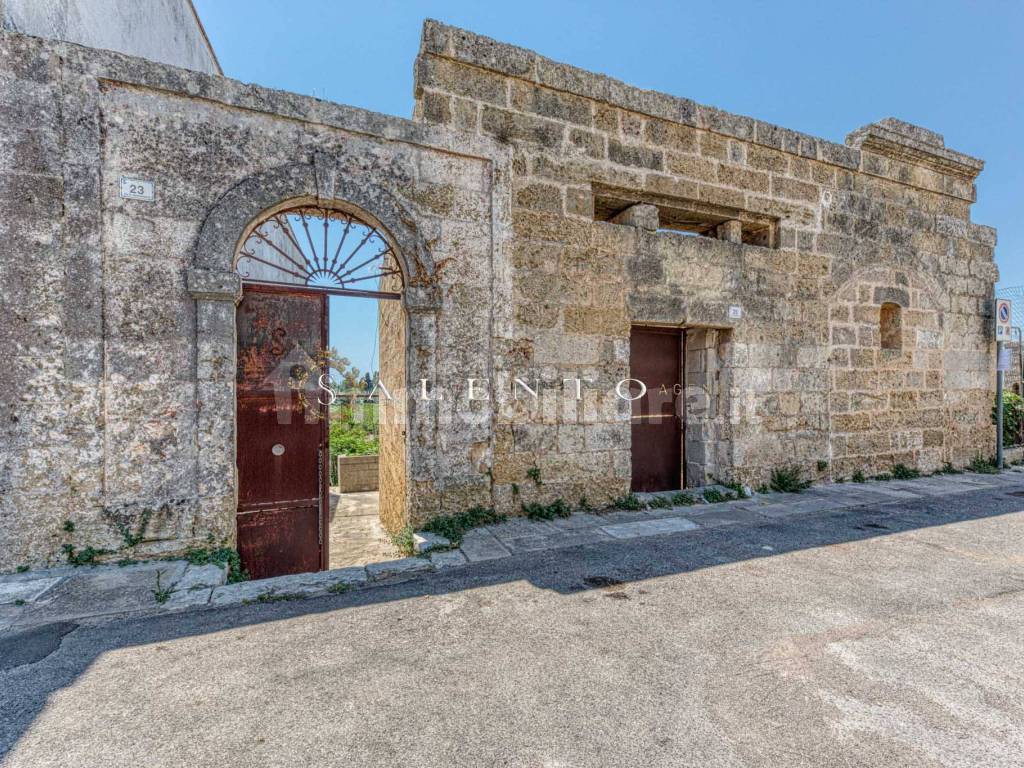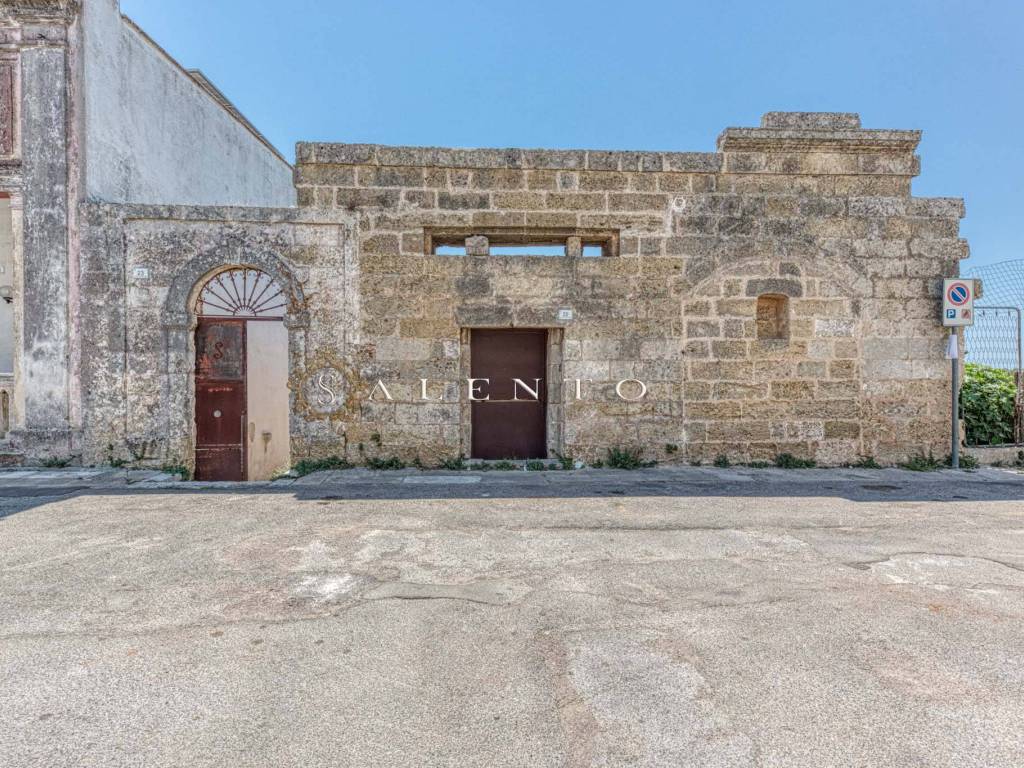1/30


Note
Listing updated on 07/16/2024
Description
This description has been translated automatically by Google Translate and may not be accurate
reference: 0318SA
In the heart of Salento and precisely in the historic center of the Municipality of Salve, Salento Agency sells a beautiful property.
Behind a small door located in Via Ettore Fierramosca there is a page of Salvese history. Looking at the main façade from street number 25, you enter a first portion of the property, consisting of two rooms, now without the roof that can be rebuilt and a third room with a typical Lecce vault. These rooms were used for the shelter of agricultural tools and as a barn and adjoining stable for working animals.
From the small door on the left side of the main façade you have access to a courtyard.
On the right of the courtyard we find a first large room with a star vault, a smaller one with a barrel vault, a third room with a star vault used as a kitchen and a fourth collapsed room (therefore that can be rebuilt) which originally had the roof with a star vault. From the room that was used as a kitchen you have the exit to a garden of about 200 square meters. The entrance courtyard also leads to the rear garden of over 500 square meters. Here we find a beautiful testimony of the Salento culture. From a small portal in tufaceous stone you go down into the subsoil where there is a beautiful underground oil mill completely dug into the rock.
We preferred to build the oil mill (or rather dig it into the rock) as the oil had to be kept at a temperature of 19/20 degrees in order to facilitate its separation from the processing water, which is why the entrance to the mill it was almost always oriented to the south in order to shelter from the north wind. The other reason why people preferred to dig was because it was more convenient both in economic terms and in terms of work. coming from the excavation of the same oil mill (so large that it cannot go out from the entrance), tubs in Lecce stone (used as containers for storing oil), mangers and the indelible signs of rubbing from the press. Time seems to have stopped when the peasants under the orders of NACHIRO. The nachiro was the one who organized the work shifts, administered the money from the offers that the customers left to the workers but in particular had the main task of separating the oil from the bilge water. Salento coasts to reach most of Europe because it was used for lighting the lamps. Usually in the mill worked from 5 to 7 unskilled workers, also called "trappitari" as well as a boy who had the task of looking after the animals, cooked, brought drinking to his colleagues and in general he carried out all those "secondary" tasks. The processing of olives usually began in the months of October / November and ended in the month of May. Throughout this period the workers did not leave the mill.
Behind a small door located in Via Ettore Fierramosca there is a page of Salvese history. Looking at the main façade from street number 25, you enter a first portion of the property, consisting of two rooms, now without the roof that can be rebuilt and a third room with a typical Lecce vault. These rooms were used for the shelter of agricultural tools and as a barn and adjoining stable for working animals.
From the small door on the left side of the main façade you have access to a courtyard.
On the right of the courtyard we find a first large room with a star vault, a smaller one with a barrel vault, a third room with a star vault used as a kitchen and a fourth collapsed room (therefore that can be rebuilt) which originally had the roof with a star vault. From the room that was used as a kitchen you have the exit to a garden of about 200 square meters. The entrance courtyard also leads to the rear garden of over 500 square meters. Here we find a beautiful testimony of the Salento culture. From a small portal in tufaceous stone you go down into the subsoil where there is a beautiful underground oil mill completely dug into the rock.
We preferred to build the oil mill (or rather dig it into the rock) as the oil had to be kept at a temperature of 19/20 degrees in order to facilitate its separation from the processing water, which is why the entrance to the mill it was almost always oriented to the south in order to shelter from the north wind. The other reason why people preferred to dig was because it was more convenient both in economic terms and in terms of work. coming from the excavation of the same oil mill (so large that it cannot go out from the entrance), tubs in Lecce stone (used as containers for storing oil), mangers and the indelible signs of rubbing from the press. Time seems to have stopped when the peasants under the orders of NACHIRO. The nachiro was the one who organized the work shifts, administered the money from the offers that the customers left to the workers but in particular had the main task of separating the oil from the bilge water. Salento coasts to reach most of Europe because it was used for lighting the lamps. Usually in the mill worked from 5 to 7 unskilled workers, also called "trappitari" as well as a boy who had the task of looking after the animals, cooked, brought drinking to his colleagues and in general he carried out all those "secondary" tasks. The processing of olives usually began in the months of October / November and ended in the month of May. Throughout this period the workers did not leave the mill.
If you want to know more, you can talk to Emanuele Colazzo.
Features
- Type
- Country house | Full ownership | Economic property class
- Contract
- Sale
- Floor
- Basement (-1), ground floor
- Building floors
- 2
- Lift
- No
- Surface
- 460 m²
- Rooms
- 5
- Bedrooms
- 3
- Kitchen
- Kitchen diner
- Bathrooms
- 1
- Furnished
- No
- Balcony
- No
- Terrace
- Yes
- Garage, car parking
- 4 in shared parking
- Heating
- Independent, with stove, powered by wood
Other features
- Closet
- External exposure
- Fireplace
- Tavern
- Window frames in glass / wood
- Single tv system
Surface detail
Residential
- Floor
- Ground floor
- Surface
- 150.0 m²
- Coefficient
- 100%
- Surface type
- Main
- Commercial area
- 150.0 m²
Other
- Floor
- Basement (-1)
- Surface
- 300.0 m²
- Coefficient
- 100%
- Surface type
- Main
- Commercial area
- 300.0 m²
Land
- Floor
- Ground floor
- Surface
- 1,000.0 m²
- Coefficient
- 1%
- Surface type
- Main
- Commercial area
- 10.0 m²
Price information
- Price
- € 280,000
- Price per m²
- 609 €/m²
Detail of costs
- Condominium fees
- No condominium fees
Energy efficiency
Energy consumption
≥ 175 kWh/m² yearG
Floorplan

Additional options
Emanuele Colazzo




























